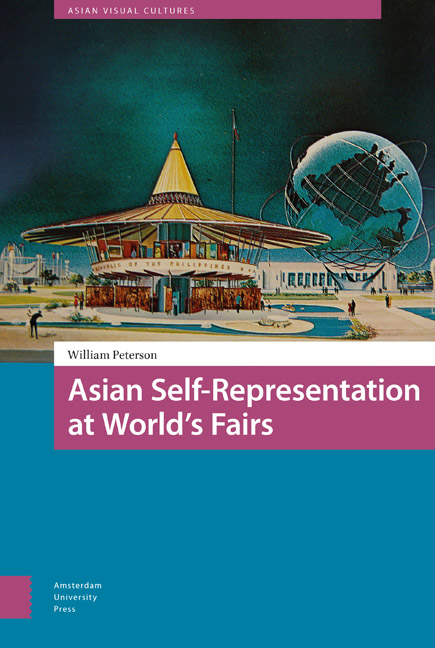Book contents
- Frontmatter
- Dedication
- Contents
- List of Figures
- Acknowledgements
- Note on Works Cited
- Note on Asian Names
- 1 Introduction: Setting the Stage
- 2 The Master of the Form: Japan at San Francisco's 1915 Panama-Pacific International Exposition
- 3 The New China and Chinese-Americanness: China at San Francisco's 1915 Panama-Pacific International Exposition
- 4 Performing Japan in the ‘World of Tomorrow’: Japan at the 1939-1940 New York World's Fair
- 5 From ‘Panda Diplomacy’ to Acrobat Diplomacy: China at the Brisbane's Expo ‘88
- 6 Fashion, Dance, and Representing the Filipina: The Philippines at the 1964-1965 New York World's Fair
- 7 Performing Modernity under Sukarno's ‘Roving Eye’: Indonesia at the 1964-1965 New York World's Fair
- 8 Maximizing Affect, Minimizing Impact with Hansik: South Korea at the 2015 Milan International Exposition
- 9 Hard and Soft Power in the Thai Pavilion: The Spectral Presence of King Bhumibol at the 2015 Milan Exposition
- 10 Conclusion: The Future of Asian Self-Representation at the International Exposition
- Works Cited
- Index
7 - Performing Modernity under Sukarno's ‘Roving Eye’: Indonesia at the 1964-1965 New York World's Fair
Published online by Cambridge University Press: 21 November 2020
- Frontmatter
- Dedication
- Contents
- List of Figures
- Acknowledgements
- Note on Works Cited
- Note on Asian Names
- 1 Introduction: Setting the Stage
- 2 The Master of the Form: Japan at San Francisco's 1915 Panama-Pacific International Exposition
- 3 The New China and Chinese-Americanness: China at San Francisco's 1915 Panama-Pacific International Exposition
- 4 Performing Japan in the ‘World of Tomorrow’: Japan at the 1939-1940 New York World's Fair
- 5 From ‘Panda Diplomacy’ to Acrobat Diplomacy: China at the Brisbane's Expo ‘88
- 6 Fashion, Dance, and Representing the Filipina: The Philippines at the 1964-1965 New York World's Fair
- 7 Performing Modernity under Sukarno's ‘Roving Eye’: Indonesia at the 1964-1965 New York World's Fair
- 8 Maximizing Affect, Minimizing Impact with Hansik: South Korea at the 2015 Milan International Exposition
- 9 Hard and Soft Power in the Thai Pavilion: The Spectral Presence of King Bhumibol at the 2015 Milan Exposition
- 10 Conclusion: The Future of Asian Self-Representation at the International Exposition
- Works Cited
- Index
Summary
Abstract
Indonesia was one of the first Asian nations to sign up for the 1964-1965 New York World's Fair, with the country's participation intimately connected to the downfall of the country's charismatic leader, President Sukarno. The erratic, brilliant, mercurial Sukarno was personally involved in the form and content of the country pavilion, reputedly selecting the attractive women who served as pavilion guides. The centerpiece of the pavilion was a theatre restaurant, which offered elaborate music and dance performances four times a day. As the US government grew increasingly hostile to Sukarno's policies and the entire Southeast Asian region became unstable, Sukarno's health and power began to fail, resulting in the nation’s withdrawal from the second year of the fair.
Keywords: Indonesia, Sukarno, dance, media representation
The case of Indonesia at 1964 New York World's Fair would appear to have much in common with the Philippines. As another formerly colonized, newly independent Southeast Asian nation with an even vaster archipelagic reach than its neighbour to the east, it also sought to represent itself in ways that championed modernity and tradition, wrapped in a national framework that celebrated cultural diversity. Yet unlike the Philippines, the Indonesian pavilion's content, design, and even its very location in New York was largely directed not by a diverse team of officials, but largely by one man: President Sukarno. Because Sukarno's fall from grace was so spectacular, with his health and grip on power rapidly declining as his country spiraled into economic chaos in a geopolitical region increasingly plagued by instability – much of it of his own making – his role in directing and shaping Indonesian culture has been a difficult one to assess openly and honestly. Sukarno's nation fell into its ‘Year of Living Dangerously’ – a phrase he famously coined – in 1965, the second year of the New York fair, and by early 1967, he was under house arrest, his reputation in tatters. Though Suharto, the military commander who eventually succeeded him as President ran the country for a vastly longer period of 31 years, it is Sukarno, for all of his failings, who is still regarded as the founder of modern Indonesia.
- Type
- Chapter
- Information
- Asian Self-Representation at World's Fairs , pp. 195 - 226Publisher: Amsterdam University PressPrint publication year: 2020



